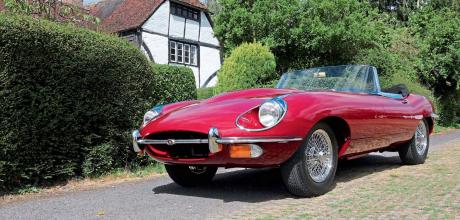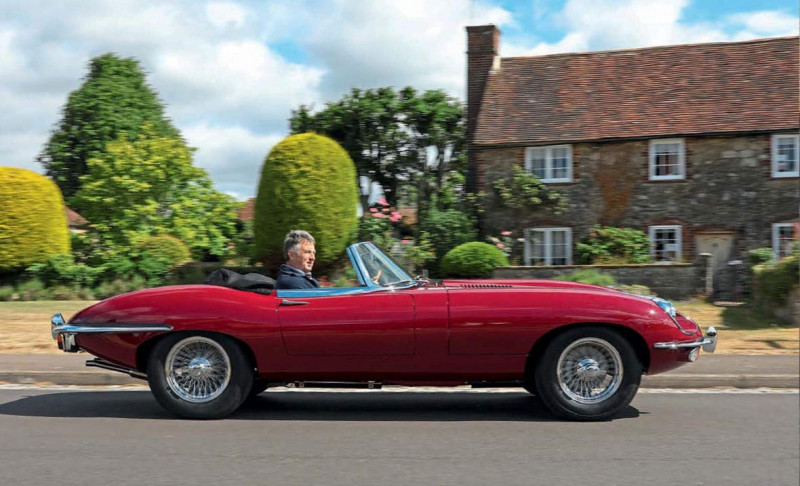Restoration 1968 Jaguar E-type Series 2

Well known for his work in the MG scene, when Mark Wanstall of London’s Fisher Services chanced upon this E-type Series 2 it helped him to realise a dream. Words & Photography Jim Jupp.
E-TYPE SERIES 2 RESTORATION: FULFILLING A DREAM CHANGE OF PACE
Mark Wanstall from MG specialist Fisher Services always wanted an E-type, a dream he fulfilled in 2012 when he found an early Series 2 in need of restoration. We go to see it.
E-types are hard to find as restoration projects, because most of them seem to have been done up already,” explains Mark Wanstall. Although an MG specialist, he’d always wanted an E-type and, in 2012, he finally became aware of a project E-type Series 2 for sale. “I heard about it fourth-hand, and bought it from a chap who owns a bodyshop.”

The car Mark found was a UK-spec 1968 Series 2 that, when he bought it, was a rolling shell. Having been partly dismantled in 1982, it had languished unloved thereafter, although thankfully had retained most of its parts. They were included as part of the package.
Mark’s car is an early version of the Series 2 from 1968, which saw amendments to lighting and the interior to conform to regulations of the time. Says Mark, “This is the 20th right-hand-drive UK E-type Series 2, so a pretty early one. Details were still changing, so things like the seat flutes on this are smooth rather than perforated, which came in later. Jaguar changed stuff all the time. They were always altering things.” Mark had a clear goal in mind for his car. “I tried to restore the Jaguar using as many of the original parts as I could. I didn’t want a new car built from after-market bits, but to re-use and re-machine as many of this Jaguar’s parts as possible to keep it as original as I could.”
In line with this ethos, Lucas items – such as the starter motor and alternator – were refurbished, even though buying new parts off the shelf may have been a quicker and easier option. It helped that Mark, through his Fisher Services business, a leading London-based MG specialist, already had relationships with local companies he knew he could trust.
“I plated everything that I could,” he adds, “All the nuts and bolts. Everything. That’s because I wanted this Jaguar’s nuts and bolts, not aftermarket replacements. That’s also why I had all the original chrome work replated rather than replaced.
“When I got the car, it was clear that someone had already undertaken some repairs to it. They had, for example, done the outer sills and bits of floor work, along with some re-spraying, but it had gone dull and a few bits of rust had come back. In fact, we had to do quite a bit of work on the bodyshell, including all the sills, centre cross member, full floors and new doors.”
The engine frame, boot bulkhead and rear panels are original with some small repairs. “The condition of the shell was more-or-less what I thought it was going to be, but putting the whole floor panels in was made easier because a big chunk of work had been done already, which was a nice bonus. To make access easier, the shell was mounted on a spit.”
Mark was willing to make some changes from the original, though, because he chose to repaint this Jaguar in Regency Red instead of its original British Racing Green, explaining, “I don’t like green cars generally and prefer the look of a Jaguar E-type in red,” he explains. “I know people who wouldn’t buy an E-type because it is green and if you don’t like it, why keep it?” He does draw a line though, adding, “I’d never paint it a colour that was non-standard for the model and year.”
All the bodywork restoration and paintwork was carried out in-house, and the two-pack solid paint looks stunning. For the high level of quality that Mark wanted to achieve, a few other items had to be replaced, including the wire wheels and tyres for reasons of both safety and practicality. “There are some bits it just makes sense to change, such as the brake discs and master cylinder,” says Mark, “but I go for the best make you can buy.” The original brake calipers have been retained as they could be refurbished, and all the rear suspension is the original, which he rebuilt. “Even on the front suspension, where parts get pitted, I re-machined them and had them plated,” he says.
The sumptuous interior is new, supplied by BAS (www.car-hood.co.uk) in Wales, which also supplied the soft top for this very detailed car. Says Mark, “BAS do full trim kits, and can even fit them for you, but I can do all that. All the seat frames were sandblasted and painted in the correct colour grey, even though you can’t see them.”
With the dash dismantled, Mark also addressed some issues with the gauges. The speedo and tachometer were cleaned up and the bezels painted, but the ancillary gauges in the middle were refurbished (by Caerbont Automotive Instruments) because, he says, “The faces inside just looked horrible.”
Aging wiring looms are an issue on any car, but this car came with a new loom, still in its bag, so naturally Mark fitted that. Before the interior was fitted, lots of Dynamat sound-damping material was applied to the inner panels. Says Mark, “I’ve never had a car without it. This one drives lovely anyway and it’s not noisy in there – there are no creaks, it’s nice and tight, and it’s comfortable. I guess it must make a difference, though, because it’s certainly not tinny.”
The engine was going to require a freshen-up at the very least, having been unused for just over two decades, and Mark took the opportunity to improve things when the block required an overbore. “The engine had a new timing chain and new pistons, while the head was re-worked with new cams. The car had done about 74,000 miles, which I think is right.
“I outsourced the engine to a company called VSC, but the owners have now retired after doing it for donkey’s years.
Everyone talks about them as being the place to go for the XK engine. That’s all they did, they never worked on anything else, and you waited about a year to get in.”
As with the engine, the gearbox was stripped and assessed, carried out by a specialist close to Mark’s South London base. Fortunately, all it needed was new bearings and seals. “I had the bellhousing vapour-blasted and the gearbox casing cleaned, then I etch-primed it, primed it, flatted it, and painted it gloss black before the cogs went back in,” he explains. “So even though you can’t see it, I know it’s right, which is the important thing.”
The gleaming triple HD8 SU carburettors were rebuilt as a matter of course, too, which one of Mark’s own specialists took care of as he also rebuilds carburettors on MGs.
“It was the same for the starter motor and alternator in that we used the same trusted companies we use for the MG rebuilds,” he says. “With the Jaguar components, it’s straightforward on items such as Lucas and SU. There’s nothing complex in it like a Ferrari, but I’d say there is more to them than an MG, even though they are similar cars really. Everything is available, too, again like MG parts, but they are more expensive. I used Martin Robey, in Nuneaton, and SNG Barratt.”
No chances were taken with the fuel tank either, which can suffer after periods of inactivity. Mark sourced one from Martin Robey, sprayed it black and then (even though you can’t see it once it’s in the boot and you’ve screwed the boards over it), he polished it. The SU fuel pump was also replaced with a new one.
A key missing part was the windscreen. Mark sourced a new one, along with door glass because the original items were too scratched.
Mark made another departure from originality when it came to the exhaust. “They were mild-steel originally, but these ones are Bell stainless steel exhausts. The Series 2 would have had a square rear numberplate, which the tail pipes would do an S around, while I’ve fitted the two straight pipes. I find the Series 1 rear exhaust layout, with the oblong numberplate and straight pipes, look smarter than the Series 2 set-up. That is about the only non-original thing that doesn’t marry up with the age and spec of the car, and that’s just personal choice.”
The finished Jaguar hasn’t gone unnoticed, which has been good for business. Says Mark, “We’d had a few customers with E-types in already, as well as a couple of Mk 2s. Since finishing it we’ve had other customers who, having seen this E-type, have gone out and bought one themselves. If people see you are competent and they like what they see, then they’re more likely to trust you with their restoration.”
Anyone who’s visited Fisher Services’ workshop will know it’s very busy, but it may come as a surprise to learn that it took Mark about seven years to complete his E-type project as it had to fit around any number of other tasks. “I did bits here and there, but it did drag on,” says Mark. “For about two years I didn’t do anything to it and built a Chevy LS3-powered MG RV8 instead – I’d had enough of the E-type. It needed a lot of time putting into it, and sometimes you need to concentrate on other projects. But I never lost sight of my aim: to build a car that is effectively an example of a car you could have bought brand new in 1968. I think I have achieved that goal.”
Thanks to: Mark Wanstall (www.fisher-services.co.uk)
THE RESTO
- 1. The BRG E-type arrives at Fisher Services
- 2. The twin-cam XK is extracted from the frame
- 3. Shell repairs included additional strengthening in the sills, as used in the 2+2
- 4. A roll-over jig makes repairs much easier
- 5. Red is the only option for Mark: Regency Red
- 6. The rebuilt rear suspension and back axle
- 7. You’ll never see it, but the fuel tank is immaculate
- 8. Seat frames were repainted before the leather seat kit was fitted
- 9. Replacement hood is attached to the frame
- 10. Rebuilt engine being re-installed
I didn’t want a new car built from aftermarket bits, but to re-use and re-machine as many of this Jaguar’s parts as possible

